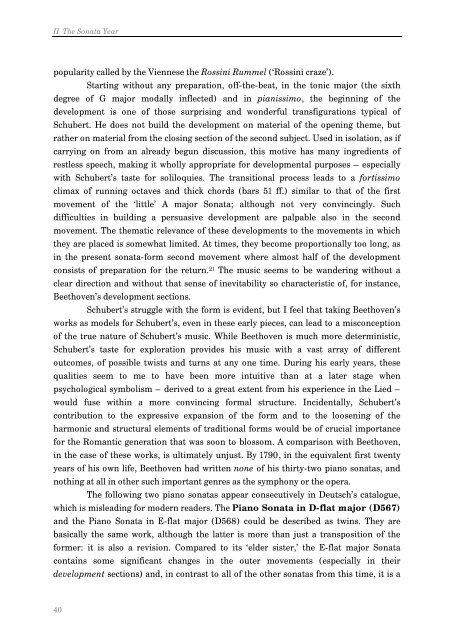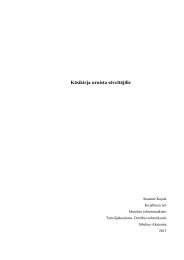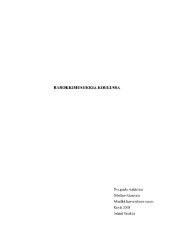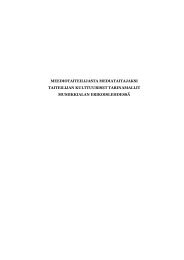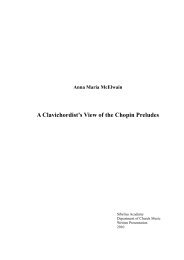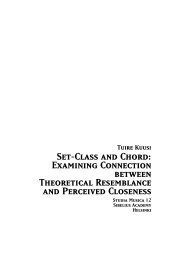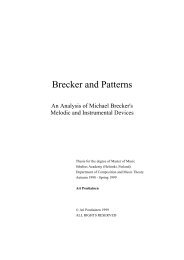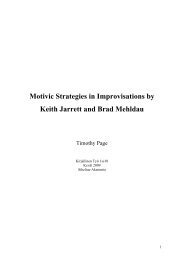The Unfinished Piano Sonatas of Franz Schubert Javier ... - Ethesis
The Unfinished Piano Sonatas of Franz Schubert Javier ... - Ethesis
The Unfinished Piano Sonatas of Franz Schubert Javier ... - Ethesis
Create successful ePaper yourself
Turn your PDF publications into a flip-book with our unique Google optimized e-Paper software.
II <strong>The</strong> Sonata Year<br />
popularity called by the Viennese the Rossini Rummel (‘Rossini craze’).<br />
Starting without any preparation, <strong>of</strong>f-the-beat, in the tonic major (the sixth<br />
degree <strong>of</strong> G major modally inflected) and in pianissimo, the beginning <strong>of</strong> the<br />
development is one <strong>of</strong> those surprising and wonderful transfigurations typical <strong>of</strong><br />
<strong>Schubert</strong>. He does not build the development on material <strong>of</strong> the opening theme, but<br />
rather on material from the closing section <strong>of</strong> the second subject. Used in isolation, as if<br />
carrying on from an already begun discussion, this motive has many ingredients <strong>of</strong><br />
restless speech, making it wholly appropriate for developmental purposes – especially<br />
with <strong>Schubert</strong>’s taste for soliloquies. <strong>The</strong> transitional process leads to a fortissimo<br />
climax <strong>of</strong> running octaves and thick chords (bars 51 ff.) similar to that <strong>of</strong> the first<br />
movement <strong>of</strong> the ‘little’ A major Sonata; although not very convincingly. Such<br />
difficulties in building a persuasive development are palpable also in the second<br />
movement. <strong>The</strong> thematic relevance <strong>of</strong> these developments to the movements in which<br />
they are placed is somewhat limited. At times, they become proportionally too long, as<br />
in the present sonata-form second movement where almost half <strong>of</strong> the development<br />
consists <strong>of</strong> preparation for the return. 21 <strong>The</strong> music seems to be wandering without a<br />
clear direction and without that sense <strong>of</strong> inevitability so characteristic <strong>of</strong>, for instance,<br />
Beethoven’s development sections.<br />
<strong>Schubert</strong>’s struggle with the form is evident, but I feel that taking Beethoven’s<br />
works as models for <strong>Schubert</strong>’s, even in these early pieces, can lead to a misconception<br />
<strong>of</strong> the true nature <strong>of</strong> <strong>Schubert</strong>’s music. While Beethoven is much more deterministic,<br />
<strong>Schubert</strong>’s taste for exploration provides his music with a vast array <strong>of</strong> different<br />
outcomes, <strong>of</strong> possible twists and turns at any one time. During his early years, these<br />
qualities seem to me to have been more intuitive than at a later stage when<br />
psychological symbolism – derived to a great extent from his experience in the Lied –<br />
would fuse within a more convincing formal structure. Incidentally, <strong>Schubert</strong>’s<br />
contribution to the expressive expansion <strong>of</strong> the form and to the loosening <strong>of</strong> the<br />
harmonic and structural elements <strong>of</strong> traditional forms would be <strong>of</strong> crucial importance<br />
for the Romantic generation that was soon to blossom. A comparison with Beethoven,<br />
in the case <strong>of</strong> these works, is ultimately unjust. By 1790, in the equivalent first twenty<br />
years <strong>of</strong> his own life, Beethoven had written none <strong>of</strong> his thirty-two piano sonatas, and<br />
nothing at all in other such important genres as the symphony or the opera.<br />
<strong>The</strong> following two piano sonatas appear consecutively in Deutsch’s catalogue,<br />
which is misleading for modern readers. <strong>The</strong> <strong>Piano</strong> Sonata in D-flat major (D567)<br />
and the <strong>Piano</strong> Sonata in E-flat major (D568) could be described as twins. <strong>The</strong>y are<br />
basically the same work, although the latter is more than just a transposition <strong>of</strong> the<br />
former: it is also a revision. Compared to its ‘elder sister,’ the E-flat major Sonata<br />
contains some significant changes in the outer movements (especially in their<br />
development sections) and, in contrast to all <strong>of</strong> the other sonatas from this time, it is a<br />
40


